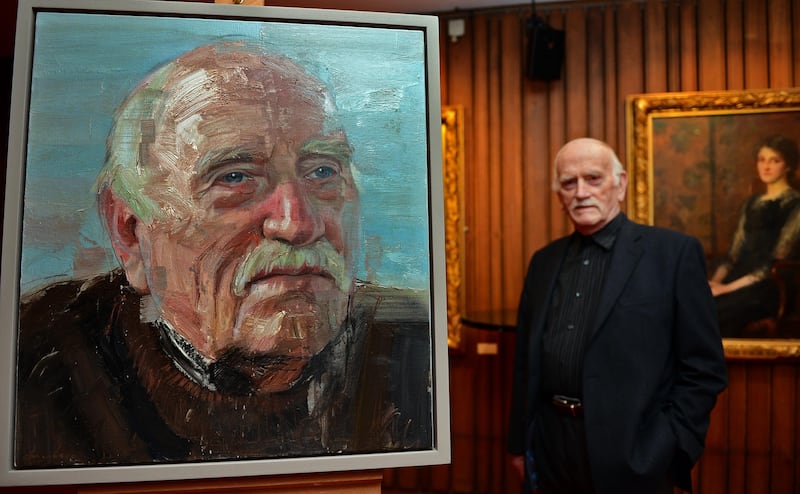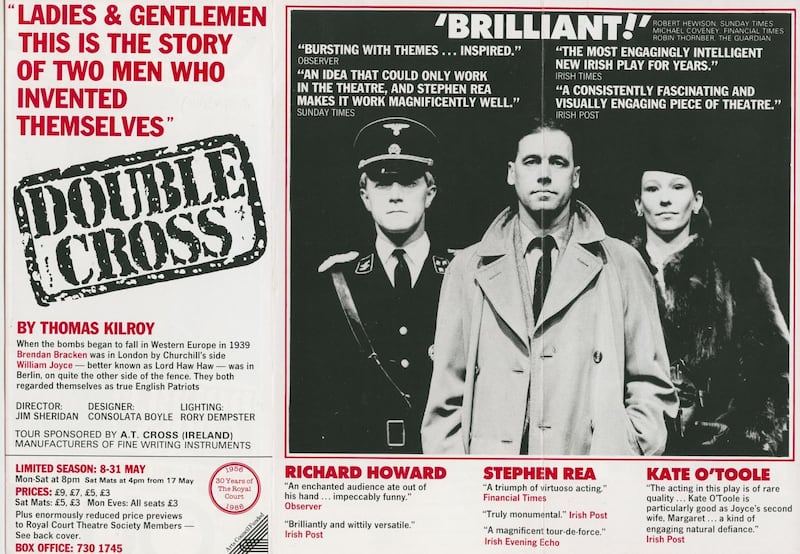In 1959, in an article for the scholarly journal Studies, Thomas Kilroy, who died on December 7th, did what you might expect of a 24-year-old art lover who worked on the periphery of a stagnant theatre industry and wanted to use his voice. He picked a fight.
Making sly references to a backward-looking scene, to “distracting monuments to the dead and glorious past of politics and art”, he argued that alternative, thrilling approaches to playwriting were being ignored. “During the past twenty-five years few Irish dramatists have been in any way exciting technically,” he wrote.
Someone who had been there took exception. Gabriel Fallon, a prominent critic (and former actor), wrote in a subsequent issue of the journal that possibly the best way in which Kilroy could bring about a new Irish theatre “would be for him to become in the shortest possible time a startlingly good Irish dramatist”.

The young, willowy Kilroy – a geek, in his own words – apparently took Fallon at his word. When his debut play, The Death and Resurrection of Mr Roche, was produced by Dublin Theatre Festival, in 1968 – the Abbey had rejected it, in what amounted to a rite of passage for breakout playwrights at the time – it became a sensation. A darkly comic, unsettling tale of homophobic assault, it was also a riff on the Resurrection – if Christ were a refined gay man from Dún Laoghaire.
Sally Rooney: ‘I enjoy writing about men ... the dangerous charisma of the oppressor class’
Alzheimer’s: ‘I’ve lost my friend and my companion,’ says Úna Crawford O’Brien of fellow Fair City actor Bryan Murray
Ryan Adams at Vicar Street: A gig that nobody will forget anytime soon, but perhaps not for all the right reasons
That was a bold premise for the Dublin of the day. Ahead of opening night, Kilroy clarified that he wasn’t trying to write about something he didn’t know about. “It is definitely not a play about homosexuals – that’s a subject on which I should be singularly ill-equipped to write. It’s about the ambiguous sexuality of men who drink together and make this their way of life. I see it as a play about a man whose manhood has been systematically destroyed by himself and the society he lives in,” he said.
Crucial to the play’s success was the ferociously good director Jim Fitzgerald, who introduced A Streetcar Named Desire and Cat on a Hot Tin Roof to many Dubliners. The timing was perfect: Kilroy got hold of Fitzgerald during a string of successes. Here Fitzgerald had to judge how best to present a late-night afterparty as a kind of underworld inhabited by disillusioned, self-destructing men, and where a dead man resurrects and says teasingly, “I’m a little ghosty-ghost. Boo-hoo!”
It’s unsurprising that Kilroy, who was the kind of technical playwright he had referred to in his Studies article, was attracted to visionary directors. When he studied at University College Dublin, in the 1950s, he spent summer breaks working in England, where he saw plays directed by Joan Littlewood and Peter Brook.
In 1977 Patrick Mason directed Kilroy’s play Talbot’s Box, a delightfully shapeshifting, poignant depiction of the Dublin folk hero Matt Talbot, a construction worker who became the nation’s most celebrated recovered alcoholic. Devoted to sobriety and God, Talbot was discovered to wear cords and chains around his body like a cilice. By the 1970s the local legend had inspired a campaign for his canonisation, but Kilroy’s play seemed suspicious of worship, drawn instead to the man’s wider biography.
The box of the title is a reference to the hods construction workers use to carry building materials, but it was also the fantastic, surreal setting that Kilroy wrote into the play: a stage resembling a gigantic wooden crate, opening to reveal a brightly lit otherworld that begins in a morgue before shifting to a construction site and a childhood home, among other settings. Kilroy was interested in Talbot as someone exploited: by religious figures seen preaching preposterously over his dead body; by greedy capitalists pointing to his dedicated work as a model for others to follow: by a guilty, violent father clutching his terrified son in order to feel better about himself. It was a concept that Mason and the set designer Wendy Shea ran with. John Molloy, one of our finest physical-theatre performers, made Talbot appear strikingly thin and skeletal, resembling a saint in desperate need of some salvation.
Kilroy’s profile was rising: his plays were transferring to London and his only novel, The Big Chapel, won the Guardian Fiction Prize in 1971. Seriously talented actors were showcasing his work. Donal McCann whirled through the surreal comedy Tea and Sex and Shakespeare, from 1976, playing a philandering playwright with writer’s block who ends up in a deadly farce manifested by his own feelings of shame and rejection. In an adaptation of Chekhov’s The Seagull for the Royal Court in 1981, which transposed the play to fin-de-siecle Ireland (when Land War bitterness was recent, and Celtic-verse plays were head-scratchingly bad), Alan Rickman played the cool, detached egomaniac artist Trigorin. Andrew Scott, barely graduated from college, was the bitchy corner of the love triangle in The Secret Fall of Constance Wilde, from 1997, as Oscar Wilde’s lover Bosie Douglas.

It was Stephen Rea, of course, who visited Kilroy and asked for a play that his Field Day company could produce. The playwright had been interested in merging the stories of two men who ran away from Ireland and fought on opposite sides in the second World War: the proud Westminster politician and Financial Times founder Brendan Bracken, and the Nazi propagandist William Joyce. The ingenious conceit was that Rea, in a virtuosic performance, would play both men, as Cain and Abel-like brothers – a balancing act allowed by uncanny video displays. The piece Kilroy wrote, Double Cross, from 1981, was arguably the first Irish play to have the requirements of a video designer written into its script.
Kilroy has often been mentioned as part of a kind of “god tier” of Irish playwrights, alongside Tom Murphy and, especially, his close friend Brian Friel. Kilroy’s imagination was more whirling and surreal. His death feels like the end of an era, like the severance of the last connection to the breakout playwrighting success of the 1950s and 1960s.
Why were Kilroy’s plays so great? Was it their daring to take on subjects that some people would disagree with? The ability to evoke the same philosophical moods as Chekhov? The meticulousness and sophistication that go into full-length plays wherein multiple storylines ping off each other? Somehow, those long, serious plays were zippy, and even funny, their pattern sometimes resembling rhythms from 1930s comedy films. Kilroy had acted in a community-theatre production of Arsenic and Old Lace; Friel eventually became friends with Katharine Hepburn. Perhaps it was because they grew up in the age of the screwballs.
Perhaps it was frustrating hypocrisy that spurred Kilroy on. When Carolyn Swift, the Pike Theatre founder, recalled the Garda shutdown of her venue’s 1957 production of The Rose Tattoo – Tennessee Williams’s play, diving into desire and rebirth, was too dangerous for some religious conservatives – she placed Kilroy as being in the building that week, working in the box office. There, at 22, he saw up close those serious attempts to censor theatre, the shocking power plays of the John Charles McQuaid era. Perhaps it never left him.
That makes Christ Deliver Us!, from 2010, seem a fitting final play: a stirring adaptation of the German playwright Frank Wedekind’s Spring Awakening, transposed to a church-run school in 1950s Kilkenny – where Kilroy grew up. It pushed the director Wayne Jordan towards his most instinctual, least self-aware work. (Again: Kilroy’s good timing with directors.) It’s a play about searching, jibing young people alive to desire – and its sad warp into abuse, in a brutally puritanical society.
Its final scene has the otherworldly half-light of The Death and Resurrection of Mr Roche, when a desperate teenager meets a priest now speaking a secular prayer, separating searchful curiosity from institutional religion. “We are born under the sign of a question mark,” says the priest.
It sounds like a useful mantra for an artist: to try to keep solving, to keep moving, as nobody has all the answers yet, to keep imagining how things could be different.
Boy, he did it with style.


















